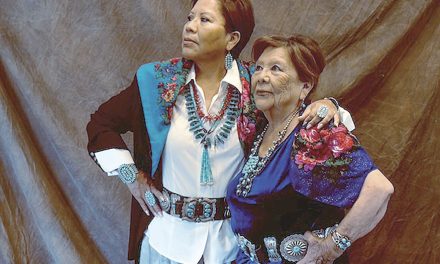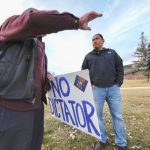
Guest Column: Extending our boundaries
November is Native American Heritage Month. As part of our observance, First Nations Development Institute asked four Native leaders to share their thoughts and observations relevant to Native American heritage in this short series called Voices from Native Communities.
By Carnell Chosa
I grew up without a father. As a team, my mother, Aunt Pat, and grandmother shared that position. And for the majority of the time, my grandfather Guadalupe Chosa filled the role.
This is probably not unique to many of our youth. And what may seem to be a deficit situation to many can also be an incredibly rewarding experience and opportunity.
It was for me.
You see, in addition to this team of substitute father figures, there was something special about growing up in a small Indigenous community where extended families shared one home and where neighbors and distant relatives were expected to participate in your growing up.
Because our people are connected through land, history and ancestry, the community shared the same core values of contribution, relationship, communality, responsibility, engagement and commitment. What moved this cultural context forward was that the focus of this transference was on youth.
My grandfather cherished this role for all his grandchildren. Growing up in his home, we found that our teaching and learning time happened over meals, but most of the time it was in the multiple farm fields we cared for in Jemez Pueblo. The core of his lesson was always that all young people have different types of gifts and talents to contribute to community. He stressed that their contribution would be more valuable in the future.
The spirit of this type of intentional and organic programming guided by a sense of responsibility, inspired by creativity, and based on community participation and values, is the framework for the Leadership Institute’s work with youth.
Founded in 1997, the Santa Fe Indian School Leadership Institute serves as a convener think tank to initiate community dialogue on issues important to communities. Specific to the institute’s youth work, this dialogue creates programming opportunities that have guiding principles of community service, mentorship/networking, critical thinking, and policy awareness.
Over the course of 20 years these guiding principles have served thousands of youth in our Summer Policy Academy, Brave Girls, Senior Honors Project, New Mexico Summer Youth Tribal Employment, Pueblo Pathways Boys Mentoring, Art and Archeology Academy, and Community Institutes.
Through this work, we have come to further appreciate how powerful and valuable youth participation is to tribal communities. You may be familiar with the saying that adults feel what they say to youth goes in one ear and out the other. Fortunately, our experience has been quite the opposite.
In our experience youth today seem to be more aware of what’s happening both internally and externally in tribal communities in regard to policy issues. Today, they are more critical of the social, economic and racial conditions that impact us personally. And they are more curious about and draw from the historical road we have traveled as a people. In our experience, they are looking to be more actively involved.
As a result, our tribal communities must respond. We must not lose the opportunity to engage a young person. As my grandfather shared with me, each young person within our relatively small communities is so valuable and has their own particular gift to contribute.
The institute took on this challenge 20 years ago and has learned that youth need opportunity. There are many ways to engage youth. For the institute, our formula is to create space where youth can exercise their voice and activate their advocacy.
Creating space for youth means giving them your time through mentorship, providing learning that is relevant to their lives as Indigenous people, and convening them so that they create a network, or community of diverse talents.
This type of resurgent space has created an exciting energy to engage in community. One interesting program, New Mexico Summer Youth Tribal Employment, is an excellent example of how we engage youth in their community.
Over the course of four summers, through generous funding from the W.K. Kellogg Foundation, the institute placed 325 youth in meaningful internships in their communities. Paying close attention to their career interest areas or majors in college, the institute worked with professionals in tribal communities and urban organizations to serve as host sites and mentors for youth.
Providing this type of space for youth to engage meaningfully during their summer created great outcomes, including tribes hiring their youth for full-time positions, offering them employment to manage tribal websites or blogs while in college, and reintroducing youth workforce programs.
The greatest outcome for the institute was igniting the engagement space so that youth know that their skills are valued and that communities know that our youth are talented, available and looking for a pathway home.
First Nations Development Institute’s blog series during Native American Heritage month is a great way to celebrate our communities. It is also a great time to reflect upon how we engage young people who are a part of our community.
Extending the boundaries of what home means is critical so that the young person contributing in the community through culture or career is just as valuable as the young person in Albuquerque or Washington, D.C., who is advocating for their community.
I believe this is what my grandfather meant when he shared that someday our communities will extend our boundaries through engaging our youth.
Carnell Chosa, Ph.D., from Jemez Pueblo, is co-director of the Santa Fe Indian School Leadership Institute.
To read the full article, pick up your copy of the Navajo Times at your nearest newsstand Thursday mornings!
Are you a digital subscriber? Read the most recent three weeks of stories by logging in to your online account.








 Highway 264,
Highway 264, I-40, WB @ Winslow
I-40, WB @ Winslow